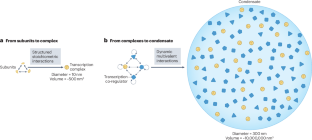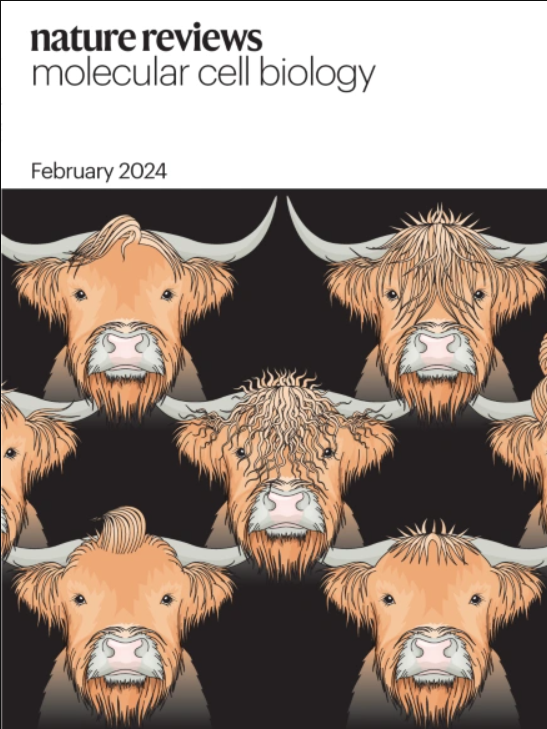生物分子凝聚体的转录调控
IF 90.2
1区 生物学
Q1 CELL BIOLOGY
引用次数: 0
摘要
生物分子凝聚体通过动态分隔转录机制来调控转录。转录调控的经典模型侧重于 RNA 聚合酶 II 的招募和调控,方法是在 1-10 nm 长度范围内形成复合物,由结构化和化学计量的相互作用驱动。这些复合物在 100-1,000 纳米长度范围内进一步组织成凝聚体,凝聚体由动态多价相互作用驱动,通常涉及结构域配体对或内在无序区。通过凝聚物介导的组织调控并不能取代 1-10 纳米尺度的过程,但它提供了在拥挤的核环境中促进或阻止这些过程的调控机制。转录凝聚物对转录的调控参与了动物和植物发育过程中的细胞状态转换、细胞信号传递和细胞对环境的反应。这些凝聚物介导的过程在发育障碍、癌症和神经退行性病变中出现失调。在这篇综述中,我们将讨论转录凝聚态调控的基本原理、它们在生理学中的作用以及它们在人类疾病中的失调。本文章由计算机程序翻译,如有差异,请以英文原文为准。


Transcription regulation by biomolecular condensates
Biomolecular condensates regulate transcription by dynamically compartmentalizing the transcription machinery. Classic models of transcription regulation focus on the recruitment and regulation of RNA polymerase II by the formation of complexes at the 1–10 nm length scale, which are driven by structured and stoichiometric interactions. These complexes are further organized into condensates at the 100–1,000 nm length scale, which are driven by dynamic multivalent interactions often involving domain–ligand pairs or intrinsically disordered regions. Regulation through condensate-mediated organization does not supersede the processes occurring at the 1–10 nm scale, but it provides regulatory mechanisms for promoting or preventing these processes in the crowded nuclear environment. Regulation of transcription by transcriptional condensates is involved in cell state transitions during animal and plant development, cell signalling and cellular responses to the environment. These condensate-mediated processes are dysregulated in developmental disorders, cancer and neurodegeneration. In this Review, we discuss the principles underlying the regulation of transcriptional condensates, their roles in physiology and their dysregulation in human diseases. Transcriptional condensates, which are formed through dynamic multivalent interactions between proteins, RNA and chromatin, regulate transcription by compartmentalizing its machinery in the crowded nuclear environment. These condensates regulate animal and plant development, cell signalling and responses to the environment, and they are dysregulated in developmental disorders, cancer and neurodegeneration.
求助全文
通过发布文献求助,成功后即可免费获取论文全文。
去求助
来源期刊
CiteScore
173.60
自引率
0.50%
发文量
118
审稿时长
6-12 weeks
期刊介绍:
Nature Reviews Molecular Cell Biology is a prestigious journal that aims to be the primary source of reviews and commentaries for the scientific communities it serves. The journal strives to publish articles that are authoritative, accessible, and enriched with easily understandable figures, tables, and other display items. The goal is to provide an unparalleled service to authors, referees, and readers, and the journal works diligently to maximize the usefulness and impact of each article. Nature Reviews Molecular Cell Biology publishes a variety of article types, including Reviews, Perspectives, Comments, and Research Highlights, all of which are relevant to molecular and cell biologists. The journal's broad scope ensures that the articles it publishes reach the widest possible audience.

 求助内容:
求助内容: 应助结果提醒方式:
应助结果提醒方式:


